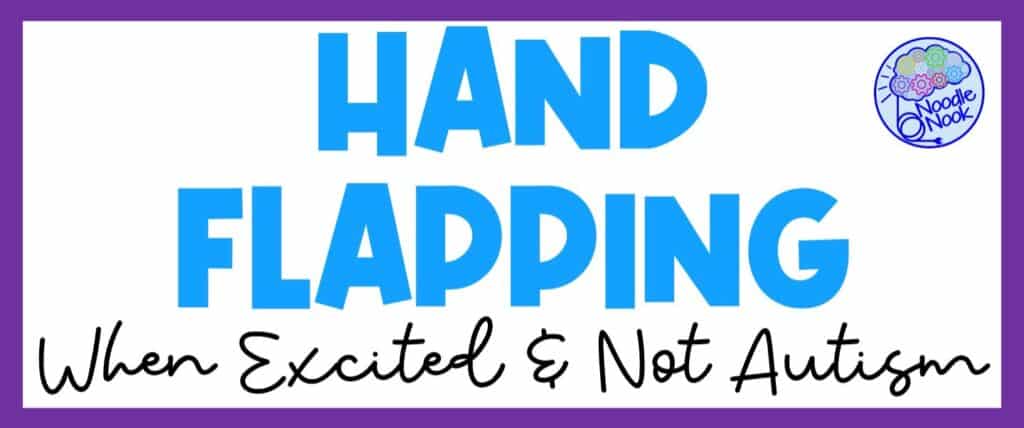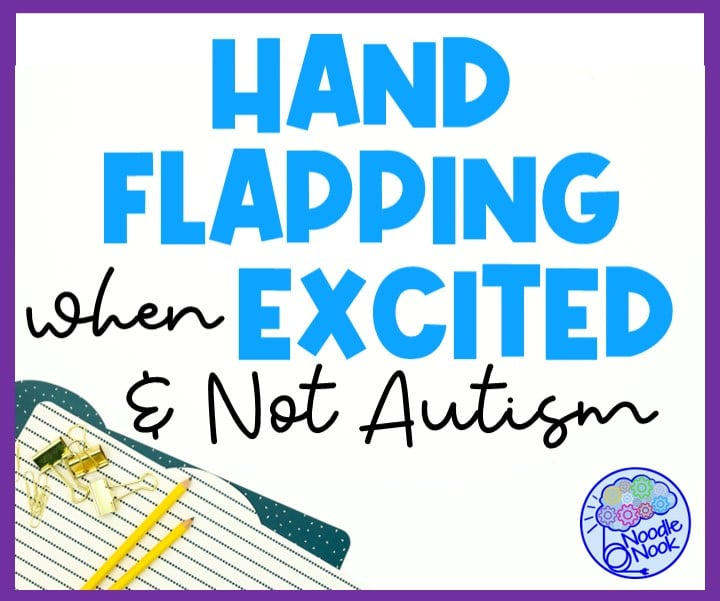If you’re here, you know someone who is hand flapping when excited not autism related. With the prevalence of autism spectrum disorder these days, most people know of someone who is autistic. When we see a person who has repetitive movements, like hand flapping, or shows signs of stimming behavior, we jump to label them as autistic. You may even think; ‘this is not normal behavior’.
It’s true that hand flapping is often thought of as a sign of autism, but it’s important to note that it can also happen in people who aren’t on the autism spectrum and have no medical conditions. Sometimes, people will flap their hands when they’re feeling excited or really emotional. It’s just a way that some people naturally show their excitement or arousal.
Do not jump to conclusions about someone’s autism status based on hand flapping alone, since that can lead to misunderstandings and hurtful stereotypes.
In this post, we’re going to dive into some great information on hand flapping when excited, including ways to help, should you choose to.
What is Hand Flapping?
Hand flapping is a type of repetitive behavior in which an individual moves their arms and hands in a way that involves quickly waving or flapping them. It is often accompanied by another repetitive motion such as rocking or pacing. Hand flapping can occur for a variety of reasons and is not necessarily a sign of a particular condition or disorder.
In some cases, hand flapping may be a form of self-regulation or a sign of a heightened emotional state. It is important to remember that hand flapping is just one behavior connected to autism or a sensory processing disorder. It should not be used to make assumptions about an individual’s overall functioning or presume a diagnosis.
What Are Common Indicators of Autism
While hand flapping is often associated with autism, it is important to note that it can occur for a variety of reasons. It’s not necessarily a sign of autism or any other particular condition or disorder. There are multiple indicators of autism that are typically not seen in isolation, but happen more than in developmentally typical children or adults.
Individuals with autism typically have several of the markers indicated here.
- Difficulty with social interaction and communication
- Lack of eye contact or difficulty maintaining eye contact
- Repetitive behaviors or routines, like forms of stimming behaviors (also known as self-stimulatory behavior), which can include auditory stimming and visual stimming
- Sensory needs, including easy sensory overload, like to loud noise or certain textures, or need for sensory input, like wanting pressure, bright lights, or textures
- Sensory processing difficulties, like difficulty processing and responding to sensory information
- Unusual body movements, such as hand flapping or rocking
- Difficulty interpreting or expressing strong emotion
- Poor social skills or difficulty interacting with peers
- Difficulty with physical pain or discomfort
- Self-injurious behavior, such as biting, head-banging, or severe hand-biting
- Inability to deal with stressful situations or process different emotional states
Please note that these indicators can vary significantly from one individual to another, and may not all be present in every individual with autism. Additionally, these behaviors can also occur in individuals who do not have autism. It is important to seek a proper evaluation from a qualified professional, such as a physician or psychologist, in order to accurately determine a diagnosis.
Hand Flapping in Non-Autistic Individuals
Hand flapping can occur in individuals who do not have autism.
In these cases, hand flapping may serve as a form of self-regulation or as a way to express excitement or pleasure. For example, an individual may flap their hands when they are feeling overwhelmed or anxious in order to self-regulate their emotions and behaviors. Similarly, hand flapping may be a natural and spontaneous way for some individuals to express excitement or pleasure in response to a positive event or activity.
Hand flapping may be a learned behavior if an individual has observed others flapping their hands and has subsequently started to imitate this behavior. This is a common occurrence, as individuals often learn and model behaviors that they observe in others. For example, an individual may see someone else hand flapping and start to do it themselves because they find it enjoyable or because they are trying to get someone’s attention. It is also possible for hand flapping to become a learned behavior through positive reinforcement, where an individual is reinforced for engaging in this behavior through the attention or other rewards that they receive as a result.
It is not uncommon for hand flapping to occur in non-autistic individuals, and it does not necessarily indicate the presence of any underlying condition. Don’t assume ‘Oh, all hand flappers are autistic people’. It is important to remember that hand flapping is just one behavior and should not be used to make assumptions about an individual’s overall functioning or diagnosis.
What To Do About Hand Flapping
If hand flapping is a behavior that occurs in an individual without autism, you may be reading this for different reasons. The main reason parents find themselves here is that they think of hand flapping as bad behavior or something that is disrupting everyday activities or daily life. Finding help is their ultimate goal and to help their child find a different way to process without flapping.
As a teacher, such behaviors may cause physical harm in a classroom full of students or interrupt learning. We may want to target the behavior to build a behavior plan or find a different way to redirect a student. So, when students are excited, it may be best to try and find ways to manage the behavior rather than attempting to eliminate it completely.
For both parents and teachers, one way to do this is by providing the individual with tools such as fidget spinners or other fidget toys to help them self-regulate.
Tips to Manage Hand Flapping
Again, keep in mind that hand flapping is about expression. You may not need to manage it at all, but rather accept it. If it is a problem that inhibits a child’s ability to interact with others, then it may need to be addressed. Consider these tips:
- Creating a quiet space for the individual to retreat to when they are feeling overwhelmed or overstimulated may also be helpful.
- Simple behavioral therapy techniques, such as teaching replacement behaviors and providing positive reinforcement for their use, can be effective in helping the individual learn alternative ways to manage their excitement or strong emotions.
- It may be helpful to seek the guidance of a qualified professional, such as a psychologist, occupational therapist, or behavior therapist, to determine the most appropriate strategies for addressing hand flapping in an individual without autism.
- Choose to do nothing and accept the flapping as part of how they show emotions without judgment.
Following through with these strategies can help you address hand flapping when excited, not autism related.
Follow-up Reading: Why Do Kids With Autism Do That?
Implications of Misattributing Hand Flapping to Autism
Hand flapping is a common behavior seen in individuals with autism, but it is important to note that not all individuals with autism exhibit this behavior, and not all individuals who exhibit hand flapping have autism. Misattributing hand flapping to autism can have significant implications for both the individual exhibiting the behavior and for the understanding and support of individuals with autism as a whole.
One of the main implications of misattributing hand flapping to autism is the perpetuation of stigma and misunderstanding surrounding autism. Many people still hold misconceptions about what autism is and what it looks like, and these misconceptions can be reinforced when hand flapping is assumed to be a hallmark of the disorder.
Accurate diagnosis is crucial for individuals with autism to receive the support and resources they need to thrive. If hand flapping is misattributed to autism, it can result in individuals being either under or over-diagnosed. Likewise, assuming a person has autism because of hand flapping can cause a stigma or impact self-worth. In other words, get it right.
Wrapping Up on Hand Flapping
Hand flapping is a behavior that can be exhibited by individuals with autism. It’s not a reliable indicator of the disorder and should not be used to make assumptions about an individual’s neurodiversity.
It is important to recognize that hand flapping can also be exhibited by neurotypical individuals when they are excited or experiencing other strong emotions.
Approach all individuals with understanding and acceptance, and seek accurate diagnosis and support for those with autism rather than relying on stereotypes or preconceptions.
Article Citation: [cite]



